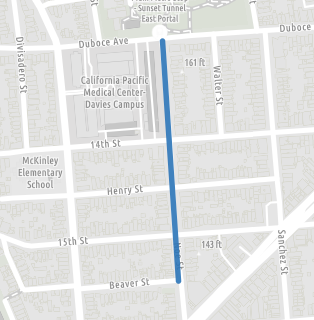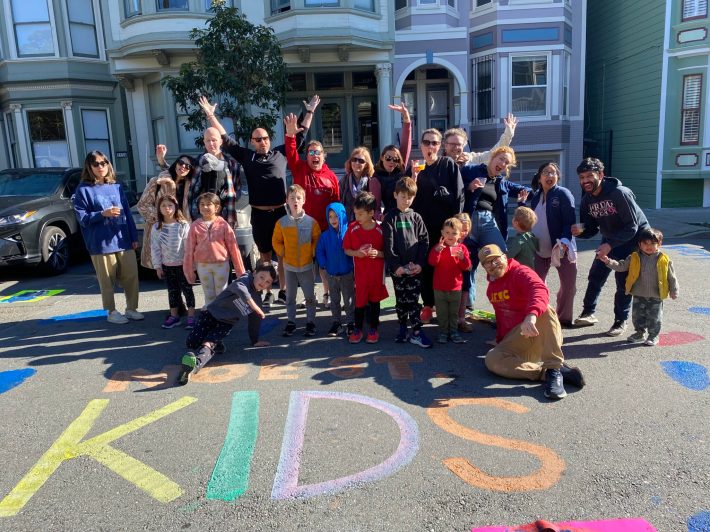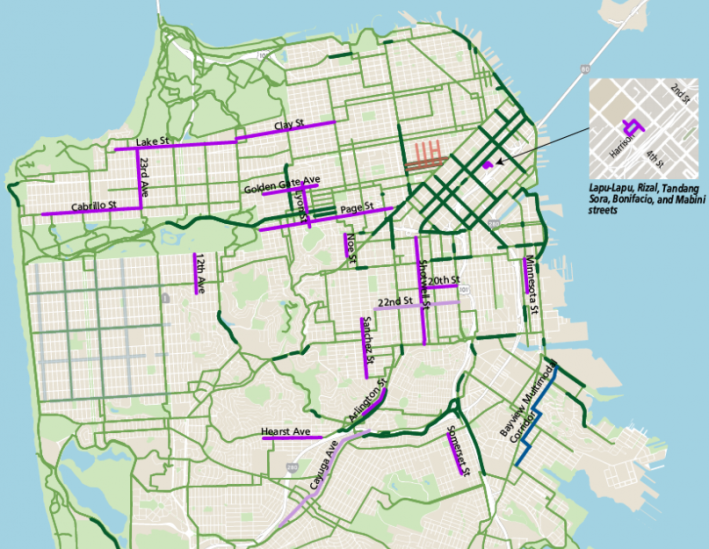Note: GJEL Accident Attorneys regularly sponsors coverage on Streetsblog San Francisco and Streetsblog California. Unless noted in the story, GJEL Accident Attorneys is not consulted for the content or editorial direction of the sponsored content.
SFMTA has removed a diverter from its plans for Slow Noe Street, despite traffic levels and speeds indicating that it is required for safety. "We don't yet have consensus to move forward on the traffic diverter at Noe and 15th Street, so are pausing work on the diverter," confirmed SFMTA spokesperson Michael Roccaforte, in an email to Streetsblog
SFMTA's internal documentation contains the following paragraph, but it was recently crossed out:

A concrete diverter island (mountable for emergency vehicles) with a bike cut-through channel will restrict drivers from entering Noe Street northbound from the 15th Street intersection. The day-lit southbound approach on Noe
Street at 15th Street would be reinforced by a Painted Safety Zone with an island or planter.
In that document (PDF), SFMTA also crossed out requirements to reduce vehicle throughput, despite a 1,000-car per day max criteria for the Slow Streets program.
Local residents were dismayed at what they described as a "behind-closed-doors" decision to remove the diverter. "SFMTA has a mandate," said advocate and Noe Street resident Pavan Yedavalli in an interview with Streetsblog. "There's still no solution to the fact that there are 1,800 cars on Noe every day. How are they solving that?"
Yedavalli stressed the importance of meeting the promised targets in order to bring more uses to the street aside from just driving. It's already the site of a farmer's market and a regular plant swap. He wants to see more events on the street.

That was, after all, the whole idea behind the city's Slow Streets program. But the city has continually allowed the program to be watered down in the face of opposition from motorists.
Streetsblog readers will recall that in 2023 the SFMTA, without discussion, removed the "local traffic only" signs from its seventeen slow streets. The agency replaced those signs—and re-opened the streets to through traffic—with plastic, purple paddle signs that simply instruct drivers to go slowly (similar to the sign on the right in the lead image). They did this just prior to public discussion on the future of the slow streets program. Leaked communications at the time showed that the mayor intended to end the slow streets program.
Nevertheless, SFMTA staff agreed to monitor car volumes and speeds. If those exceeded certain thresholds, the agency was supposed to bolster physical restrictions on designated slow streets until speeds were reduced to 15 mph and car volumes to 1,000 per day.

"My four-year-old had been learning to ride a bike on our street," said Yedavalli. But over time things have changed. "It's now extremely dangerous. The slow street is extremely compromised."
A local advocate described a June meeting at the Duboce Triangle Neighborhood association, which included drivers opposed to the diverter and the slow street. "There was a group of five to ten neighbors who were very loud, very aggressive, and very rude," wrote the advocate, who asked Streetsblog to withhold their name out of fear of retaliation from neighbors. "SFMTA was there to present their traffic calming proposal of a northbound traffic diverter and speed cushions, to try to get under the 1,000 cars per day and 15 mph average speed guidance." They added that SFMTA officials were "extremely poised, and deserve a lot of credit—it can’t have been easy to deal with that amount of vitriol."
Safe streets advocates in the area are convinced this subset of vitriolic neighbors got the ear of Supervisor Rafael Mandelman, whose district includes Noe Street. "SFMTA Slow Streets staff I spoke with this weekend again confirmed that your office 'killed' this project. Can you confirm this? Additionally, can you please define 'consensus' in this context?" wrote advocate Adam Egelman in an email to the Supervisor that was forwarded to Streetsblog. "This issue is not going away—my neighbors at 15th & Noe feel incredibly betrayed by your office."
SFMTA Slow Streets staff involved in the project did not reply to Streetsblog's inquiries. However, "I want to be clear that our office has not instructed MTA to stop pursuing the northbound diverter," wrote Calvin Ho, legislative aide to Mandelman. "We have simply asked staff to consider the needs of all neighbors who live or work in Duboce Triangle when coming up with solutions to decrease car volumes in the neighborhood."
The push to remove the diverter echos a similar effort on Slow Page Street. However, in that case Supervisor Dean Preston lobbied hard to keep the traffic diverter at Divisadero. The diverter is there today, albeit using only plastic posts. A concrete diverter is currently being designed.
Streetsblog asked Mandelman's office if he supported the diverter on Noe or fought to save it, the way Preston did on Divisadero, rather than just supporting 'consensus.' Streetsblog will update this post.
Advocates who spoke with Streetsblog, meanwhile, described spending months gathering signatures and working towards building support for a concrete diverter. They told Streetsblog that they got that consensus, but "they nixed the diverter altogether behind closed doors," said Yedavalli.
"During our plant swap, with probably twenty children there, a driver just zoomed up and shouted 'get out of the middle of the street, you fucks' on a sunny Saturday morning," he said. "We claim we're a city for people, for families, for active sustainability, but here we are coddling drivers."





